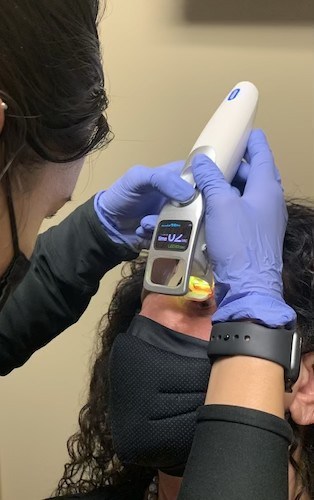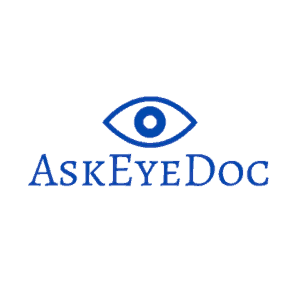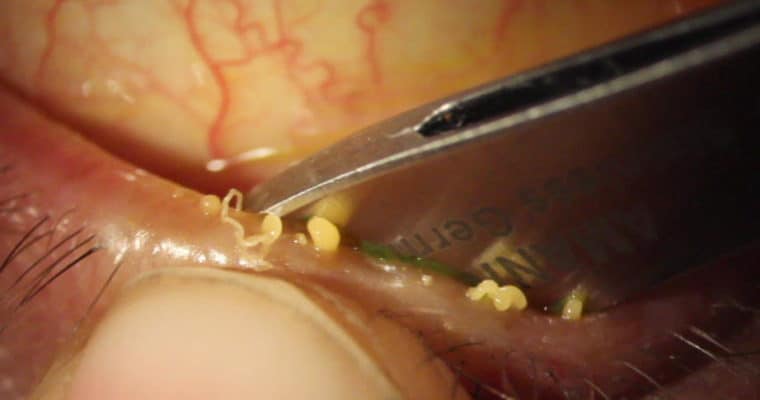Written By: Dr. Stephanie Mulick, O.D.
Are your eyelids red and swollen? Do you wake up with crusty eyelids and blurry vision?
Here are 3 steps to improve red, swollen, crusty eyelids.
- Clean face and eyelids
- Apply a Hot compress to closed eyes for 10-20 minutes
- Wipe eyelids clean with baby shampoo or eyelid cleaners such as OcuSoft eyelid wipes or Systane Lid Wipes.
When the glands of the eyelids are blocked with thick buttery oil, it can cause us to wake up with our eyelids matted together causing inflammation and blurry vision. The glands of the eyelids are called Meibomian glands.
The meibomian glands are responsible for producing the oily component of our tears, which helps to keep our eyes moist.
What is Meibomian Gland Dysfunction and Blepharitis?
In order to understand Meibomian Gland Dysfunction and Blepharitis, it is important to understand the anatomy of the eyelids.
Anatomy of the eyelids
I like to describe our cornea like the windshield of our car and the eyelids like the windshield wipers. There are small glands that line the upper and lower eyelids called the meibomian glands (illustrated below) that are like the misters of our windshield wipers. There are about 50 meibomian glands in our upper eyelid and about 30 in our lower eyelid, which are stimulated to produce tears with each blink.
The Meibomian glands produce an oily tear to help prevent tear film evaporation which helps to keep the tears on our eyes longer and prevent the cornea from drying out.
Meibomian Gland Dysfunction (MGD):
One of the main causes of dry eye syndrome is Meibomian gland dysfunction (click here for more detail on dry eye syndrome causes and treatments).
Meibomian gland dysfunction means that the small glands lining the upper and lower eyelids become blocked with thick oil causing Meibomian gland obstruction and inflammation (Imagine the misters of your windshield wipers getting clogged).
Sometimes you can see your own clogged meibomian glands in the mirror, the lid margin may have a notch or divot or you may see oil caps along the margin of your eyelid. This is much easier to see with a high powered microscope, called a slit lamp that the Eye Doctor will use to examine your eyes.
When the Meibomian glands are clogged, tear production decreases and symptoms of dry eye syndrome can present. Even though the meibomian glands are blocked the lacrimal gland will still work to produce the aqueous layer of the tear; this can lead to symptoms of watery eyes. In some cases, a clogged meibomian gland can lead to inflammation and cause or stye or chalazion. To find out more read my post on Styes and Chalazion.
This photo shows the thick oil being pushed out of the meibomian glands
Meibomian Gland Dysfunction Treatment:
- Clean face and eyelids
- Apply a Hot compress to closed eyes for 10-20 minutes
- Wipe eyelids clean with baby shampoo or eyelid cleaners such as OcuSoft eyelid wipes or Systane Lid Wipes.
This can be done 1-2 times per day
The best treatment for MGD is heat to melt the oil that is clogging the meibomian glands.
You can do this by using a hot compress mask (click here to for my post on amazon hot compress reviews), a hot bowl of water with a lid, and two washcloths that you would alternate in succession to maintain heat, I have even heard of patients using hot potatoes or hot tea bags. As long as you can keep the heat on the eyelids for 10-20 minutes. Less than 10 minutes does not allow the oil enough time to melt.
Make sure to clean your face and eyelids prior to using a hot compress. After about 10-20 minutes of heat make sure to clean the eyelids well to wipe clean the melted oils. You want to make sure to use a product that will cut the oil, just wiping the eyelids with a wet cloth will not remove the oil. Products such as Ocusoft lid scrubs (I prefer the OcuSoft Plus that does not need to be rinsed off and has antibacterial properties), Systane Eyelid Wipes or even baby shampoo work well for cleaning the eyelids.
The length of time using hot compresses is much more beneficial than the number of times you use the hot compress. It is common for my patients to tell me that they use hot compresses until the hot cloth gets cold about 3-4 minutes several times per day. Really, this is just wasting your time. Think about melting butter, if you don’t heat it long enough it will not melt, the same goes for the oil in the meibomian glands.
Although tedious, it is important to have the heat on the eyelids for a minimum of 10 minutes.
Longer is usually better; however, you don’t want to heat your eyelids longer than 20 minutes because heat can cause inflammation. Don’t be surprised if after the heat treatment your eyes seem more red and inflamed, that is normal.
Your Eye Doctor can prescribe a topical ointment that can help reduce the risk of inflammation and infection.
Do not use vaseline on your eyes, it will only increase meibomian gland dysfunction.
There are expensive treatments that can be used to express the Meibomian glands by heating and compressing the glands using a device called Lipiflow or iLux.
ILUX
At Tayani Institute, we use a device called ILUX. The device is used to heat and express the Meibomian glands so that the thick oil clogging the glands can melt. Allowing the glands to start functioning properly to produce tears to keep our eyes moist.

This procedure can be very effective for the treatment of Meibomian gland Dysfunction.
Most patients find that the treatment can improve symptoms for 6-12 months.
If you continue using hot compresses and cleaning the eyelids results can last longer.
ILUX Procedure
ILUX is an in-office procedure usually performed by a trained technician.
The procedure takes about 9 minutes per eye.
What to expect with ILUX treatment:
When the device is placed on the eyelids you will see bright light for about 1 minute. It is similar to laying out in the sun with your eyelids closed.
For most patients, the procedure is not uncomfortable and some have even described it as relaxing.
The lower eyelid will be treated twice and the upper eyelids will be treated once.
What to do after the ILUX procedure:
After ILUX it is still recommended to use hot compresses and eyelid cleaners such as baby shampoo, OcuSoft lid scrubs, or Systane lid wipes to get the maximum benefits of the ILUX.
Even without continued hot compresses, you should still experience relief in symptoms.
Symptoms of Meibomian gland Dysfunction:
- Red, swollen eyelids
- Red, irritated eyes
- Gritty, sandy sensation
- Some people experience tearing
- Thick, crusty eyelids upon waking
Blepharitis:
Blepharitis and Meibomian Gland Dysfunction go hand in hand. Blepharitis is a medical term that means inflammation of the eyelids. It presents with a dandruff-like buildup on the base of the eyelashes, increasing the risk for infection and inflammation; therefore, leading to dry eye syndrome. It is important to have your Eye Doctor examine your eyelids for blepharitis and recommend the proper treatment.
Treatment for Blepharitis:
The Treatment for Blepharitis is the same as Meibomian gland dysfunction. Again, you want to heat up the eyelids for 10-20 minutes and wipe them clean with either baby shampoo or special eyelid cleaning pads such as Ocusoft or Systane Lid Wipes. It is sometimes necessary to use a prescription eye ointment from your Eye Doctor.
Conclusion
Meibomian Gland Dysfunction is one of the most common causes of dry eye syndrome which can cause red, irritated eyes, and eyelids, a sensation of something in the eye, crusty eyelids in the morning and for some excessive tearing.
Treatment should include hot compresses, eyelid cleaning, and artificial tears as needed (click here for Doctor recommended Artificial tears).



Hey! This is my first visit to your blog! We are a group of volunteers and starting a new project in a community in the same niche. Your blog provided us valuable information to work on. You have done a outstanding job!
I wish I could find a doctor in Wyoming. I was in tears when I discovered your website. I have been suffering from Meibomian Gland Dysfunction for several years. I have seen several doctors including a dermatologist that said I had no hope because it was probably milia. Unfortunately I don’t think I can make the trip to CA for treatment. I am beside myself knowing there is a potential cure but it’s out of reach. Thank you for the informative article.